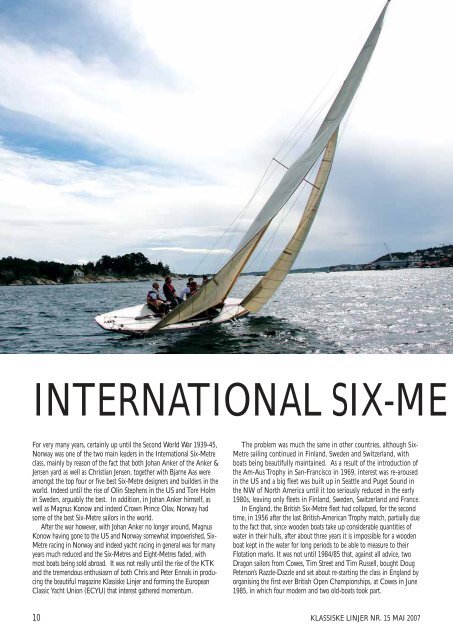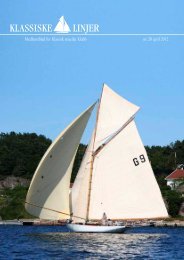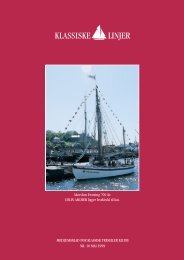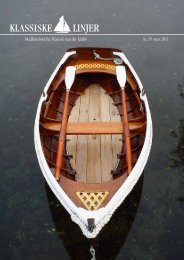Klassiske Linjer nr 15 mai 2007 - Klassisk Treseiler Klubb
Klassiske Linjer nr 15 mai 2007 - Klassisk Treseiler Klubb
Klassiske Linjer nr 15 mai 2007 - Klassisk Treseiler Klubb
Create successful ePaper yourself
Turn your PDF publications into a flip-book with our unique Google optimized e-Paper software.
INTERNATIONAL SIX-ME<br />
For very many years, certainly up until the Second World War 1939-45,<br />
Norway was one of the two <strong>mai</strong>n leaders in the International Six-Metre<br />
class, <strong>mai</strong>nly by reason of the fact that both Johan Anker of the Anker &<br />
Jensen yard as well as Christian Jensen, together with Bjarne Aas were<br />
amongst the top four or five best Six-Metre designers and builders in the<br />
world. Indeed until the rise of Olin Stephens in the US and Tore Holm<br />
in Sweden, arguably the best. In addition, in Johan Anker himself, as<br />
well as Magnus Konow and indeed Crown Prince Olav, Norway had<br />
some of the best Six-Metre sailors in the world.<br />
After the war however, with Johan Anker no longer around, Magnus<br />
Konow having gone to the US and Norway somewhat impoverished, Six-<br />
Metre racing in Norway and indeed yacht racing in general was for many<br />
years much reduced and the Six-Metres and Eight-Metres faded, with<br />
most boats being sold abroad. It was not really until the rise of the KTK<br />
and the tremendous enthusiasm of both Chris and Peter Ennals in producing<br />
the beautiful magazine <strong><strong>Klassisk</strong>e</strong> <strong>Linjer</strong> and forming the European<br />
Classic Yacht Union (ECYU) that interest gathered momentum.<br />
The problem was much the same in other countries, although Six-<br />
Metre sailing continued in Finland, Sweden and Switzerland, with<br />
boats being beautifully <strong>mai</strong>ntained. As a result of the introduction of<br />
the Am-Aus Trophy in San-Francisco in 1969, interest was re-aroused<br />
in the US and a big fleet was built up in Seattle and Puget Sound in<br />
the NW of North America until it too seriously reduced in the early<br />
1980s, leaving only fleets in Finland, Sweden, Switzerland and France.<br />
In England, the British Six-Metre fleet had collapsed, for the second<br />
time, in 1956 after the last British-American Trophy match, partially due<br />
to the fact that, since wooden boats take up considerable quantities of<br />
water in their hulls, after about three years it is impossible for a wooden<br />
boat kept in the water for long periods to be able to measure to their<br />
Flotation marks. It was not until 1984/85 that, against all advice, two<br />
Dragon sailors from Cowes, Tim Street and Tim Russell, bought Doug<br />
Peterson’s Razzle-Dazzle and set about re-starting the class in England by<br />
organising the first ever British Open Championships, at Cowes in June<br />
1985, in which four modern and two old-boats took part.<br />
10 KLASSISKE LINJER NR. <strong>15</strong> MAI <strong>2007</strong>






